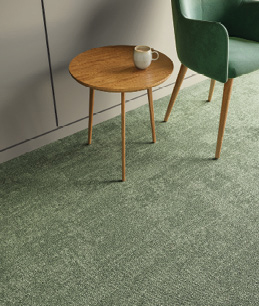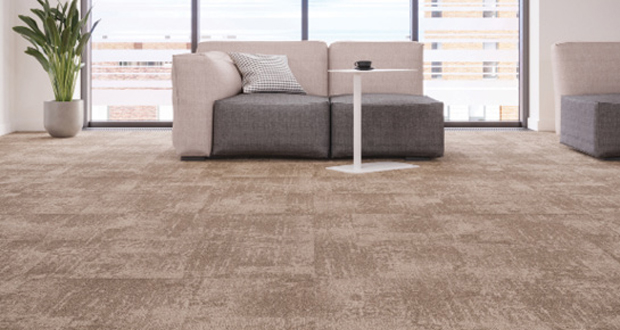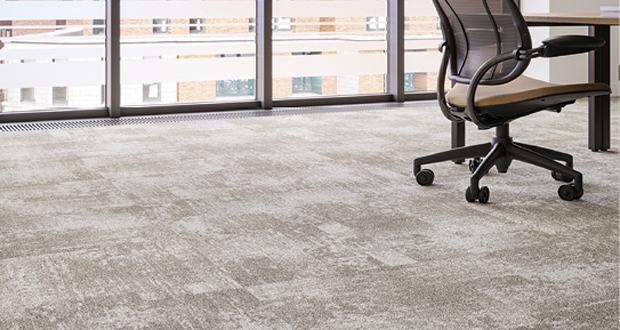Creating exciting, welcoming and productive workspaces can help encourage the return of workers to the office. Here Lewis Cooper, Marketing Executive from Forbo Flooring Systems explains the factors to consider
With 46 per cent of professionals saying that their workplace has a big impact on their productivity levels , facilities managers are posed with an interesting challenge. Following potentially long periods of time spent working from home, they must find ways to create workspaces that employees want to return to. To do this, they must first consider the factors involved in creating an inviting workspace, one that encourages collaboration and productivity.
COLOUR
 Studies from across the world have shown the impact colour can have on productivity and mood, with different colours stimulating different emotions. For example, the use of yellow, which connotes happiness and excitement, can be useful for office décor, helping to inspire employees to come up with new and innovative ideas. Alternatively, the colour blue can create a calming effect, useful for offices where activities require detailed focus. Incorporating these colours into your office space can aid in improving employees’ productivity when in the workplace.
Studies from across the world have shown the impact colour can have on productivity and mood, with different colours stimulating different emotions. For example, the use of yellow, which connotes happiness and excitement, can be useful for office décor, helping to inspire employees to come up with new and innovative ideas. Alternatively, the colour blue can create a calming effect, useful for offices where activities require detailed focus. Incorporating these colours into your office space can aid in improving employees’ productivity when in the workplace.
As the largest area in any space, flooring can be a key component in executing this, by selecting the aforementioned colours in your chosen flooring solution. As well as helping to create a calming and productive environment, the use of colour can also help an office to be seen as a more desirable workspace, especially when compared to those with dull and uninspiring environments.
BRINGING THE OUTSIDE IN
Another design factor to consider when looking to increase work productivity is biophilic design, with one study finding that office workers were 15 per cent more productive when there were houseplants added to their workspace. The benefits of biophilic design to an employee’s health are not just physical, but mental too. By incorporating more references to the outdoors, employees will feel more connected to their surroundings, which can increase their mood – all of which can have the knock-on effect of increasing productivity. Not only this, if employees find their working environment to be interesting and creative, it will likely be easier to both retain and attract new talent too.
Biophilic design isn’t just adding plants or greenery to a space; it can also be as simple as connecting employees to nature through the use of products that are reminiscent of the outdoor environment. Flooring can again play a part in this, with certain flooring solutions having a natural looking aesthetic, thus bringing the outdoors in. For instance, Forbo’s Tessera Infused range of carpet tiles, a multi-height loop pile carpet tile, has a beautiful, organic aesthetic and is available in a range of contemporary earthy, natural colours.
NATURAL LIGHT
Similarly, adding more natural light to a space can help to improve employees’ physical and mental health. With a plentiful supply of natural light, there can be up to an 18 per cent rise in productivity, with sunlight also having been shown to help decrease stress and improve sleep. By adding more windows to your office space, you can be proactive in bringing sunlight into the workspace. Additionally, by specifying products with a high LRV (Light Reflectance Value) you can ‘bounce’ light around a space. Typically, the lighter the colour, the higher the LRV. However, this doesn’t mean picking the lightest possible flooring scheme or paint, but rather combining your chosen flooring solution with a corresponding paint scheme on the walls. This can reflect light around a space, which can in turn boost the energy levels of employees.
ZONES AND SPACES
One of the most recommended ways to create better workspaces is by reconfiguring the layout, whether by adding or removing desks or by changing the way they are set out. This can encourage hot-desking – where employees share the same desk – or even enable break-out spaces to be added into areas that previously housed desks.
By creating a clear difference in design between these areas, you can help to zone out areas for employees, helping them to focus in work areas and relax in social spaces. One way to do this is by changing the flooring for each area. For a social area, consider using something more vibrant and colourful, which connotes relaxation. Whereas in the workspace, something more subdued, to create a more calming and focused environment.
Similar to this, using the same flooring for linked areas can help to guide employees around the office, thus connecting the whole office together by providing a pathway of sorts.
The modern office needs to cater to its workforce and provide staff with a welcoming, positive and productive environment, one that has a positive impact on employees’ wellbeing. This can be achieved by incorporating natural colours and lighting into the office space, thus increasing employee energy levels and productivity, as well as using flooring to help zone out different areas and spaces. Using a mixture or even all of these factors can help to create a better and more productive working environment and help to attract workers back into offices.






